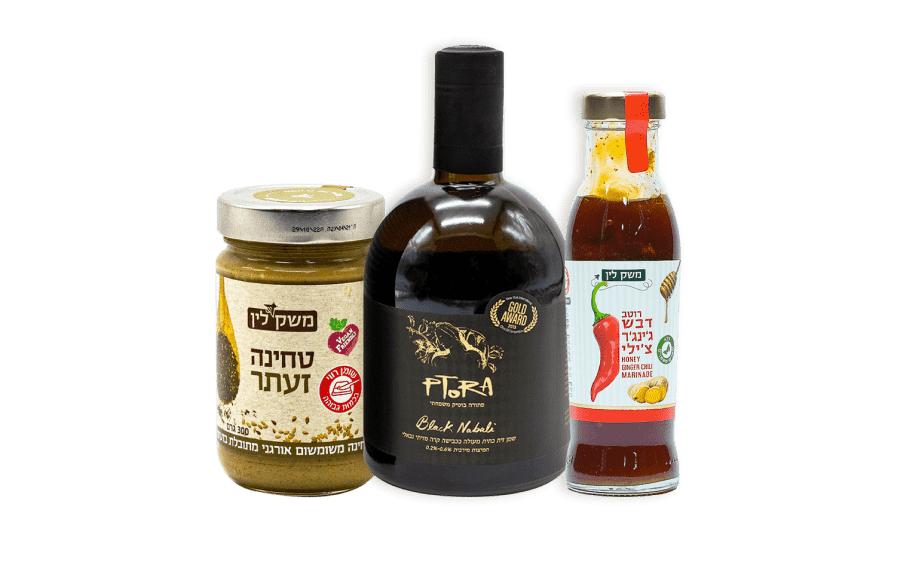With its origins going back hundreds of years to Iraqi Jewry, Sabich has been transformed from a traditional Shabbat morning breakfast to an Israeli street food snack that rivals falafel!
On most street corners in the Holy Land, you can always find a falafel stand selling Israel's most popular snack. However, in recent years, there is another street food which has become a serious contender, called Sabich, also served inside a warm pitta bread. Brought to Israel by Jewish immigrants from Iraq, Sabich has become increasingly popular as foodies discovered the delicious combination of slow-cooked hard-boiled eggs, tahini sauce, and deep-fried aubergine slices and are left craving more! For Sabich to be authentic, it needs time. Time to really brown the eggs and let the flavors develop, time to remove the bitterness from the aubergines and fry them to perfection, and when it comes to serving, no time at all as the customers are eager to try this incredible street food!
From the Jewish homes of Baghdad to the Streets of Israel.
The ingredients of Sabich slow-cooked hard-boiled eggs, and deep-fried aubergine would make up the traditional Shabbat morning breakfast for the Jewish communities of Iraq. As those who observe Shabbat are not permitted to light a fire on Shabbat, the aubergine would be pre-fried before Shabbat. The eggs were prepared as part of the main meal for Shabbat day.
This chicken and rice dish, called "Hamin" would be cooked in a large pot over charcoal embers from Friday night until ready to be served the next day. Above the pot, eggs would be placed, and everything would be wrapped in towels to keep the steam in. The results are beautiful brown eggs filled with the delicious flavors of the main dish! When the Iraqi Jewish community emigrated to Iraq, they brought along their culinary knowledge. They fused it with the flavors and ingredients commonly found in Israel, such as tahini and pita bread, and then Sabich was born!
This chicken and rice dish, called "Hamin" would be cooked in a large pot over charcoal embers from Friday night until ready to be served the next day. Above the pot, eggs would be placed, and everything would be wrapped in towels to keep the steam in. The results are beautiful brown eggs filled with the delicious flavors of the main dish! When the Iraqi Jewish community emigrated to Iraq, they brought along their culinary knowledge. They fused it with the flavors and ingredients commonly found in Israel, such as tahini and pita bread, and then Sabich was born!

Let's make Sabich together for the family!
Slow-cooked eggs:
For the fried eggplant:
For the tahini sauce:
- 6 large eggs
- 2 black tea bags
- 2 Tbsp Turkish coffee
- 2 quarts water
For the fried eggplant:
- 1 large eggplant
- 4 Tbsp kosher salt
- ½ cup cornstarch
- canola oil, for frying
For the tahini sauce:
- 1 garlic clove
- 16-ounce (500 ml) jar tahini
- juice of 1 lemon
- 1 tsp ground cumin
- 1 Tbsp kosher salt
- 1-1½ cups ice water
To serve:
Warm pitta bread, fresh Israeli salad (finely chopped cucumber, tomato, onion),
chopped parsley, and Amba (Mango pickle sauce!)
chopped parsley, and Amba (Mango pickle sauce!)
Directions
1: Make the eggs ahead.
Preheat the oven to 200°F [95°C]. Mix all the ingredients with the water in a large ovenproof pot. Cover and bake for at least 8 hours or up to 12 hours.
2: Remove the pot from the oven.
Crack but do not peel the eggs, then return them to the pot with the liquid. Set the pot on the stovetop and cook over high heat, uncovered, until almost all the liquid has evaporated, about 20 minutes (watch closely, the eggs will explode if the pot gets too dry). Cool the eggs on a plate, then peel and slice.
3: Make the fried eggplant.
Strip the eggplant lengthwise with a vegetable peeler and trim off the ends. Slice into 12 roughly ½-inch (12 mm) thick rounds. Sprinkle each eggplant slice on both sides with the salt and drain on a wire rack set on a baking sheet for 1 hour.
4: Pat the slices dry with paper towels.
Put the cornstarch in a shallow bowl. Dredge the eggplant in the cornstarch on both sides and tap off the excess. Place a large skillet over medium heat and coat the bottom with oil. When the oil is hot, fry the eggplant in batches for about 2 minutes per side, or until golden. With a spatula, transfer the eggplant to paper towels to drain. Cool slightly before assembly.
5: Make the tahini sauce.
Nick off a piece of the garlic (about a quarter of the clove) and drop it into the bowl of a food processor. Add the lemon juice to the bowl. Pour the tahini on top, making sure to scrape it all out of the container, and add the cumin and salt. Process until the mixture looks peanut buttery, about 1 minute, then stream in the ice water a little at a time with the motor running. Process until the mixture is smooth and creamy and lightens to the color of dry sand.
6: Assemble ingredients.
Use a fresh pita and drizzle with tahini on top.
Preheat the oven to 200°F [95°C]. Mix all the ingredients with the water in a large ovenproof pot. Cover and bake for at least 8 hours or up to 12 hours.
2: Remove the pot from the oven.
Crack but do not peel the eggs, then return them to the pot with the liquid. Set the pot on the stovetop and cook over high heat, uncovered, until almost all the liquid has evaporated, about 20 minutes (watch closely, the eggs will explode if the pot gets too dry). Cool the eggs on a plate, then peel and slice.
3: Make the fried eggplant.
Strip the eggplant lengthwise with a vegetable peeler and trim off the ends. Slice into 12 roughly ½-inch (12 mm) thick rounds. Sprinkle each eggplant slice on both sides with the salt and drain on a wire rack set on a baking sheet for 1 hour.
4: Pat the slices dry with paper towels.
Put the cornstarch in a shallow bowl. Dredge the eggplant in the cornstarch on both sides and tap off the excess. Place a large skillet over medium heat and coat the bottom with oil. When the oil is hot, fry the eggplant in batches for about 2 minutes per side, or until golden. With a spatula, transfer the eggplant to paper towels to drain. Cool slightly before assembly.
5: Make the tahini sauce.
Nick off a piece of the garlic (about a quarter of the clove) and drop it into the bowl of a food processor. Add the lemon juice to the bowl. Pour the tahini on top, making sure to scrape it all out of the container, and add the cumin and salt. Process until the mixture looks peanut buttery, about 1 minute, then stream in the ice water a little at a time with the motor running. Process until the mixture is smooth and creamy and lightens to the color of dry sand.
6: Assemble ingredients.
Use a fresh pita and drizzle with tahini on top.

One of the most wonderful things about living in the Holy Land is that we get to enjoy a wide variety of foods and drinks from different communities around the world. Indian, Iraqi, Yemenite, Eastern European, North African, French, Asian, the Jewish people who emigrated to Israel brought with them beautiful cultures and culinary skills, making Israel the number one place to enjoy edible delights from across the entire world!
Sabich is just one of many signature dishes of an ancient Jewish community from Iraq. From a simple Shabbat morning meal to becoming one of Israel's most popular street foods, it is a testimony to the success of the millions of immigrants who fled anti-Semitism and persecution around the world, especially in the Middle East. Arriving in Israel with sometimes only the clothes on their backs, they were rich in their knowledge, skills, and desire to live and work in the Holy Land and they succeeded!
Sabich is just one of many signature dishes of an ancient Jewish community from Iraq. From a simple Shabbat morning meal to becoming one of Israel's most popular street foods, it is a testimony to the success of the millions of immigrants who fled anti-Semitism and persecution around the world, especially in the Middle East. Arriving in Israel with sometimes only the clothes on their backs, they were rich in their knowledge, skills, and desire to live and work in the Holy Land and they succeeded!

There is so much goodness in that Land of Israel that only a monthly subscription can give you the ability to experience and benefit from it!
The Holy Land is filled with abundant goodness that God promised the Jewish people. A Land flowing with Milk and Honey and home to the seven species of wheat, barley, grapes, figs, pomegranates, olive oil, and (date) honey. From pottery makers to artists, farmers to bakers, cosmeticians to winemakers, and olive growers, there is an abundance of items being produced by the pioneers of Israel! From the north in the Golan Heights to the south in the Negev Desert, the East in the holy city of Jerusalem, and the coastal cities in the West, there are communities and people with stories to tell and share with you.
Our monthly surprise packages entwine these stories with those of the Bible and the Land of Israel. Within are 7 to 9 products connecting you to the Holy Land, and with each additional package, you are able to discover more about Israel than ever thought possible, feel its love, and really get to know the people and places behind each wonderful product.
Our monthly surprise packages entwine these stories with those of the Bible and the Land of Israel. Within are 7 to 9 products connecting you to the Holy Land, and with each additional package, you are able to discover more about Israel than ever thought possible, feel its love, and really get to know the people and places behind each wonderful product.









